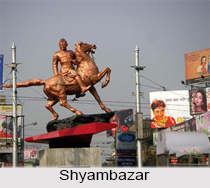 Shyambazar is a neighbourhood and the early urban settlement in northern part of Kolkata. It is now the place of street shopping and during the British era, Shyambaar was the heaven of theatres and operas.
Shyambazar is a neighbourhood and the early urban settlement in northern part of Kolkata. It is now the place of street shopping and during the British era, Shyambaar was the heaven of theatres and operas.
Location of Shyambazar
Shyambazar is now the busy street in the northern part of Kolkata. The area, under Shyampukur police station of Kolkata Police, has been, along with neighbouring Bagbazar, the citadel of the Bengali aristocracy, in a part of what was earlier known as Sutanuti.
Market in Shyambazar
There was a big market in the area, which Holwell called Charles Bazar. The present designation was conferred upon it by Sobharam Basak, in honour of Shyam Rai, the attendant of the goddess Kali. The Basaks and the Sheths were amongst the first to have settled in Sutanuti, after having cleared the jungles. Sobharam Basak was one of the wealthiest native inhabitants of 18th century Kolkata.
Development in Shyambazar
Shyambazar has the growth and development of the region and surrounding localities largely followed the construction of roads that opened up the area. Sutanuti had no roads, except the pilgrimage path extending across it from Halisahar to Barisha. Chitpur Road (renamed Rabindra Sarani) was developed along this path. It passed through neighbouring Bagbazar and Chitpur. Road construction picked up in the early 19th century. The Lottery Commission (1817) and its successor the Lottery Committee (1836) opened up the native parts of old Kolkata. The main axial thrusts were from south to the north, parallel to the existing Chowringhee - Chitpur alignment.
Discovery of Maratha Ditch
The three-mile long Maratha Ditch was excavated in 1742 as a protection against the prowling Maratha soldiers then foraging in the countryside but who never came .It was filled up in 1799 to build the Circular Road, that ran from Shyambazar, right around old Kolkata, covering the southern end of the Maidan.
Modern Shyambazar
Modern Shyambazar was metalled in the early 19th century. Around the same time the most important axial thoroughfare from south to north was around Wood Street, Wellesley Street, Wellington Street, College Street and Cornwallis Street where were built by the Lottery Committee. The new road to Barrackpur and R.G.Kar Road also converged at the same point. Subsequently, the extension of Central Avenue (the Shyambazar end is now called Bhupen Bose Avenue), which was built by the Kolkata Improvement Trust formed in 1911, also converged on the same point, making Shyambazar five-point crossing one of the busiest street crossings in Kolkata.



















